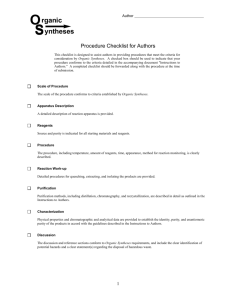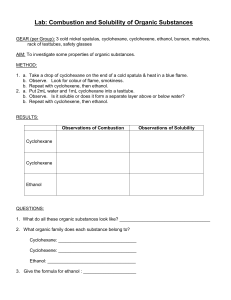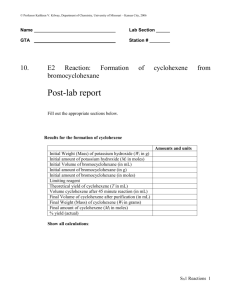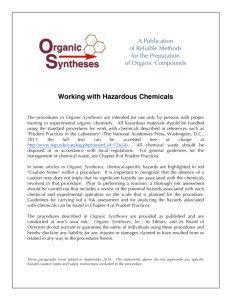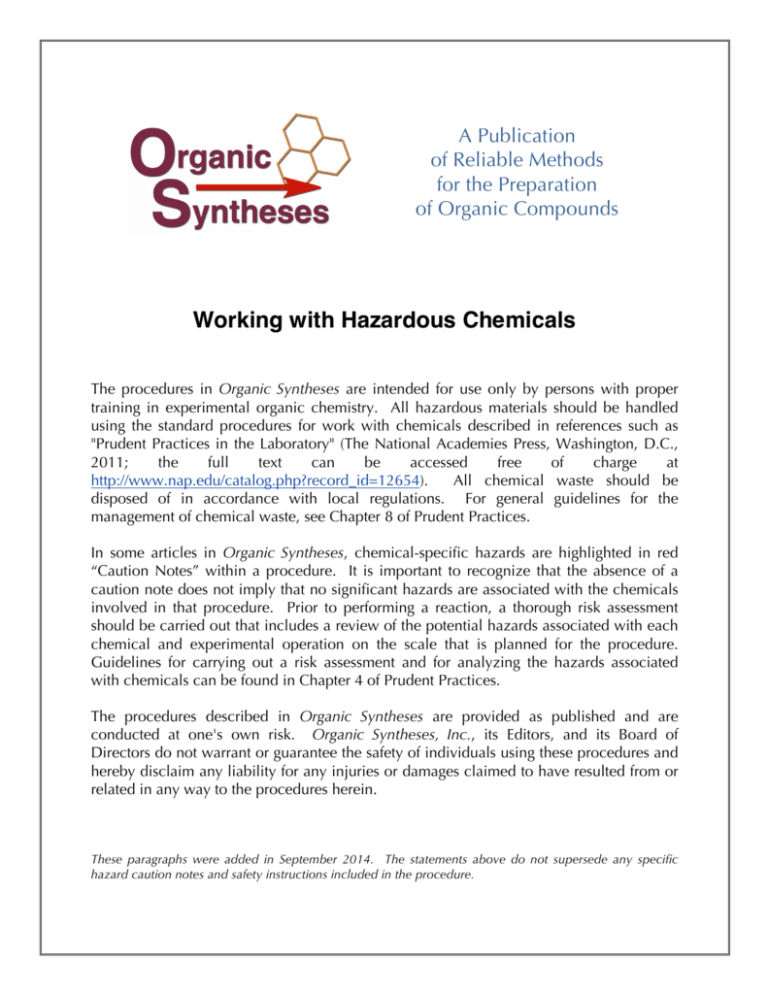
A Publication
of Reliable Methods
for the Preparation
of Organic Compounds
Working with Hazardous Chemicals
The procedures in Organic Syntheses are intended for use only by persons with proper
training in experimental organic chemistry. All hazardous materials should be handled
using the standard procedures for work with chemicals described in references such as
"Prudent Practices in the Laboratory" (The National Academies Press, Washington, D.C.,
2011;
the
full
text
can
be
accessed
free
of
charge
at
http://www.nap.edu/catalog.php?record_id=12654).
All chemical waste should be
disposed of in accordance with local regulations. For general guidelines for the
management of chemical waste, see Chapter 8 of Prudent Practices.
In some articles in Organic Syntheses, chemical-specific hazards are highlighted in red
“Caution Notes” within a procedure. It is important to recognize that the absence of a
caution note does not imply that no significant hazards are associated with the chemicals
involved in that procedure. Prior to performing a reaction, a thorough risk assessment
should be carried out that includes a review of the potential hazards associated with each
chemical and experimental operation on the scale that is planned for the procedure.
Guidelines for carrying out a risk assessment and for analyzing the hazards associated
with chemicals can be found in Chapter 4 of Prudent Practices.
The procedures described in Organic Syntheses are provided as published and are
conducted at one's own risk. Organic Syntheses, Inc., its Editors, and its Board of
Directors do not warrant or guarantee the safety of individuals using these procedures and
hereby disclaim any liability for any injuries or damages claimed to have resulted from or
related in any way to the procedures herein.
These paragraphs were added in September 2014. The statements above do not supersede any specific
hazard caution notes and safety instructions included in the procedure.
DOI:10.15227/orgsyn.005.0035
Organic Syntheses, Coll. Vol. 1, p.185 (1941); Vol. 5, p.35 (1925).
CYCLOHEXENE OXIDE
[Cyclohexane, 1,2-epoxy-]
Submitted by A. E. Osterberg
Checked by C. S. Marvel and A. B. Adams.
1. Procedure
In a 2-l. round-bottomed flask fitted with a mechanical stirrer is placed a solution of 70 g. (1.75
moles) of sodium hydroxide in 400 cc. of water. To this solution is then added 230 g. (1.71 moles) of 2chlorocyclohexanol (p. 158). The mixture is stirred vigorously for about one hour (Note 1). The stirring
is then stopped and the upper layer is separated and fractionated carefully through an efficient column.
The fractions collected are 100–129°, 129–134°, and 134–175° (Note 2). The first fraction is mainly
cyclohexene oxide but contains some water which is separated with a separatory funnel before the
second fractionation. After the fraction boiling at 100–129° is collected, the condenser should be
removed and dried thoroughly before collecting the second fraction, in order to insure anhydrous
material. After two or three fractionations, the yield of cyclohexene oxide boiling at 129–134° is 117–
122 g. (70–73 per cent of the theoretical amount).
2. Notes
1. If the stirring is continued for much longer than one and one-half hours, the yield may be lessened
somewhat.
2. There is a slight high-boiling residue which begins to decompose if the temperature is raised above
this point. The products of decomposition are hard to remove from the distilling flask.
3. Discussion
Cyclohexene oxide can be prepared from 2-iodocyclohexanol1 or 2-chlorocyclohexanol2 and
alkalies; and by the oxidation of cyclohexene with perbenzoic acid.3
This preparation is referenced from:
z
Org. Syn. Coll. Vol. 4, 232
References and Notes
1. Brunel, Compt. rend. 136, 384 (1903); 137, 62 (1903); Bull. soc. chim. (3) 29, 883 (1903).
2. Godchot and Bedos, Bull. soc. chim. (4) 37, 1454 (1925).
3. Godchot and Bedos, Compt. rend. 174, 462 (1922).
Appendix
Chemical Abstracts Nomenclature (Collective Index Number);
(Registry Number)
sodium hydroxide (1310-73-2)
Cyclohexene (110-83-8)
2-Chlorocyclohexanol (1561-86-0)
Cyclohexene oxide,
Cyclohexane, 1,2-epoxy- (286-20-4)
2-iodocyclohexanol
Perbenzoic acid (93-59-4)
Copyright © 1921-2005, Organic Syntheses, Inc. All Rights Reserved

